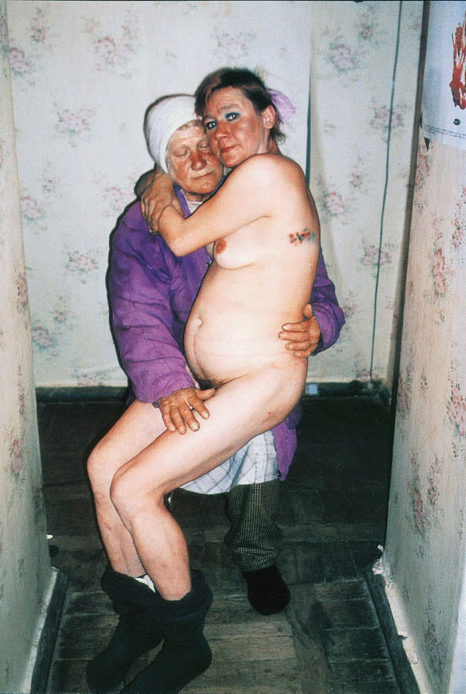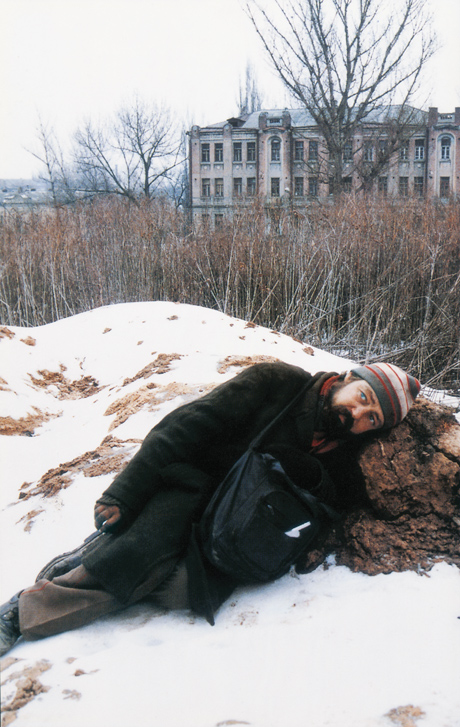[Winter 2012]
Boris Mikhailov
Museum of Modern Art, New York
26 May to 5 September 2011
During the Soviet era, it was unlawful to photograph anything that contradicted the reigning political ideology. As images were seen to be an extremely forceful argument to support the cause, anything that might show signs of rust on the well-oiled machine would not be tolerated. The negation of an outlet for visual evidence to the contrary of the accepted narrative attests to the very power of the documentary photograph, for it bears silence witness when it is too dangerous to speak the truth. Born in Ukraine in 1938, Boris Mikhailov lost his job at a camera factory after the KGB discovered that he had taken nude photographs of his wife. Following his dismissal, he turned to the camera to make a living, and he later began to exhibit his work. After the fall of communism and time spent in Berlin on an artist’s stipend, Mikhailov returned to his hometown of Kharhov, the second-largest city in Ukraine. Unsettled by the changed social landscape of the city, he set about documenting the living conditions of the homeless, or bomzhes. This largely ignored underclass did not fit in with the newfound ideology of capitalism, seen as a cure-all for the evils of the previous era.
Mikhailov’s resulting photographic series begun in 1997, Case History, is composed of more than 400 images, a large number of which were published in an anthology in 1999. The portraits are disturbingly graphic and voyeuristic, and they call into question the consequences of wholeheartedly displacing one dogma for another one that is equally flawed. The photographs featured in the exhibition are large-scale, untitled chromogenic prints, tacked onto the walls with pins. Some of the compositions were spontaneous interactions between photographer and subjects, whereas others were specifically arranged by Mikhailov. All of the images possess a strong performative or narrative sense, perhaps due in part to the fact that the subjects were paid to participate in the project; most of them stare directly into the camera, engaging directly with the viewer while exposing not only their living conditions, but also, in many cases, their bodies in various states of undress. Like players in a sideshow, they invite viewers to peer into the underside of society from a safe distance and without fear of getting their hands dirty.
In one portrait, a man lies on his side in the snowy foreground of the landscape, resting his head on a rock as though it were a pillow. It is winter, and although he is somewhat equipped for the cold weather, it is obvious that his ill-fitting clothes have been better days. Behind him are a sparse expanse of brush and a few lonely leafless trees. In the background is a large building, a material reminder of the city’s former glory as an industrial centre.
Another photograph taken in the same location features a couple, also posed during winter. The man is shirtless and posed crouching beside a tree, while a woman stands next to him, wearing a man’s overcoat, with her head covered by a hat and scarf. Their relationship with one another is unclear. The focal point of the image is the man’s bare chest, bearing a tattoo of Lenin’s face. It is an anachronism that serves as a visual reference to the man’s past before he became one of the nameless bomzhes, as well as a point of interrogation: although hardships were kept out of sight, might some people have been better off before the fall of communism? Moreover, what are the social implications of knowledge? If the plight of other people is put squarely before you, does an implied responsibility come with seeing it?
Mikhailov’s photographs of homeless youths are especially troubling. In one image, three children are engaged in conversation. Their heads have been shaved; they are covered in grime and lightly dressed in dirty clothes. They sit on the stone steps of an undisclosed location. The girl is in the middle of telling a story and uses her hands for emphasis. One hand partially obscures the face of a small boy sitting next to her. Once again, Mikhailov deliberately creates the sensation that we can’t fully absorb the whole picture. To do so would defeat the purpose of his exploration. He wants the experience to be open-ended, so that the viewer will be haunted by what is uncovered.
Exposing the faces of those who are ignored or largely forgotten has long been the territory of photography. Looking at them in Mikhailov’s book, one might react by simply closing it. Confronted by life-size portraits on the gallery walls, however, it is almost impossible to look away. The photographs are disturbing in their raw brutality and sear themselves into the viewer’s memory. As such, they might operate as a remedy to the erasures of a previous era.
Johanna Mizgala is a curator and critic based in Gatineau. One of her ongoing preoccupations is humour in early photographic portraits and how such examples of wit, spontaneity, spirit, and transgression transcend distinctions of race, class, and gender.


